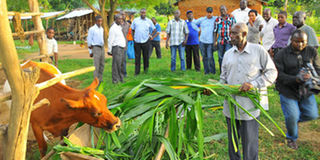Ugandans to benefit from agribusiness academy

A farmer feeding his cow with pasture. This is one of the projects in the AAA model village
What you need to know:
The village approach will imply that AAA entrepreneurs are impacting the lives of underprivileged farmers and helping them to turn them from subsistence farmers to small commercial farmers, earning money and improving their livelihoods in real monetary terms
KAMPALA
Uganda is set to be the first beneficiary of the Africa Agribusiness Academy (AAA) ‘Village Model’ aimed at increasing food security in Africa.
The inaugural village model which has been established in Kirika sub-county, Kibuku district, Eastern Uganda will be replicated in Western, Northern, West Nile and Central regions of the country.
If successful, it will also be replicated in Kenya, Rwanda, Tanzania and Ethiopia according, to Farid Karama, the AAA country director.
The rationale behind the idea is to complete integration of AAA member’s services and activities that AAA members can offer, but with community stakeholders carrying out implementation.
“Traditionally, communities have developed their own systems for dealing with almost anything. They have learned to better utilize these systems, to work together in a more coordinated manner, and ultimately be able to provide comprehensive growth for themselves,” he said
“We believe that the AAA companies can really change many lives of the people in the communities that we are working in, only that this time these companies are not working individually but as a group offering services and products as complete as possible at affordable costs,” said Dr Stephen Birungi, the project coordinator.
AAA members shall also empower the farmers especially in the production of more and better quality agricultural products in partnership with agri-businesses which sell to them inputs or buy raw materials from them.
The village approach will imply that AAA entrepreneurs are impacting the lives of underprivileged farmers and helping them to turn them from subsistence farmers to small commercial farmers, earning money and improving their livelihoods in real monetary terms.




